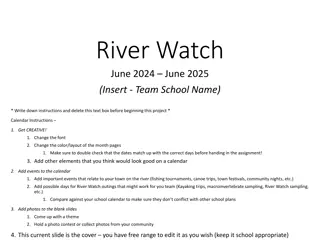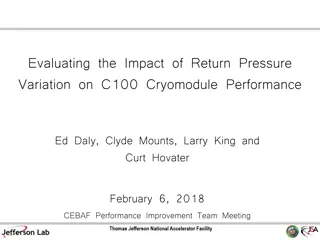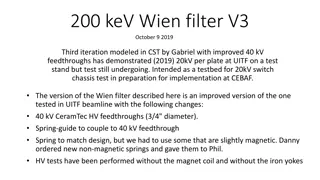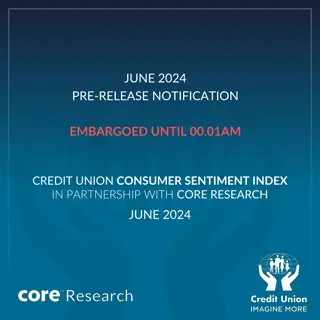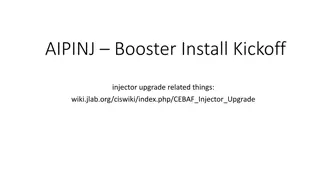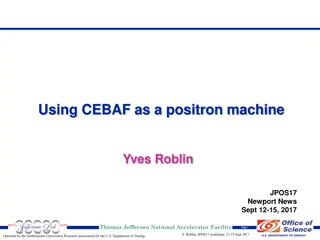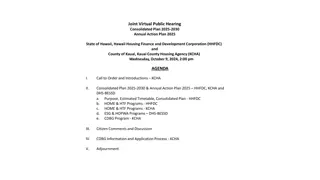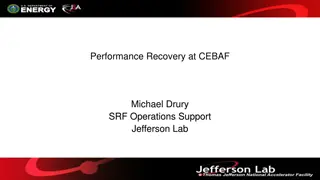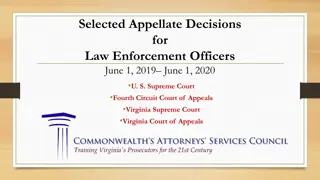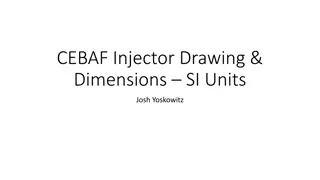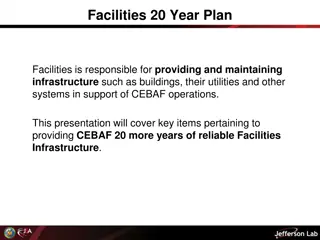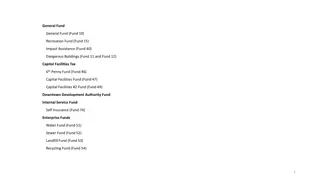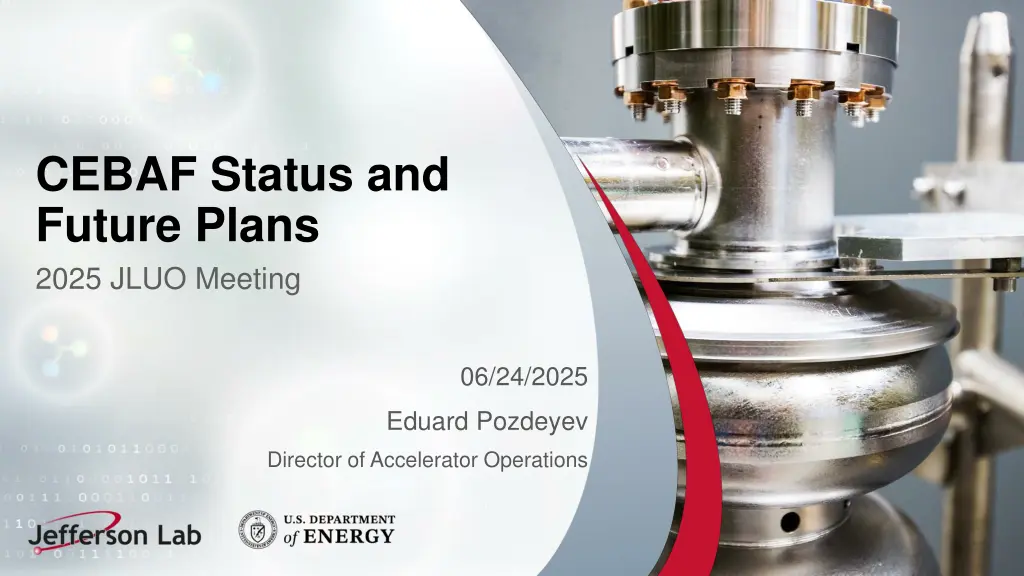
CEBAF Accelerator Updates and Future Plans
Stay informed about the latest updates and future plans for the CEBAF accelerator operations as outlined by Eduard Pozdeyev, Director of Accelerator Operations. Explore performance details, energy reach projections, ongoing activities, reliability statistics, trip rates, and upcoming plans for 2026. Get insights into beam intensity enhancements, reliability improvements, and the impact of weather conditions on operations.
Download Presentation

Please find below an Image/Link to download the presentation.
The content on the website is provided AS IS for your information and personal use only. It may not be sold, licensed, or shared on other websites without obtaining consent from the author. If you encounter any issues during the download, it is possible that the publisher has removed the file from their server.
You are allowed to download the files provided on this website for personal or commercial use, subject to the condition that they are used lawfully. All files are the property of their respective owners.
The content on the website is provided AS IS for your information and personal use only. It may not be sold, licensed, or shared on other websites without obtaining consent from the author.
E N D
Presentation Transcript
CEBAF Status and Future Plans 2025 JLUO Meeting 06/24/2025 Eduard Pozdeyev Director of Accelerator Operations
Outline Present (FY25 Run) performance Energy Reach projections Moller-related activities and progress JLAAC and restart reviews, and actions Future upgrades 6/28/2025 Eduard Pozdeyev, Accelerator Update 2
2025 Run 22 weeks of Physics + 2 weeks of beam restore E = 11.7 GeV (energy gain per linac 1060 MeV) Beam power up to 900 kW Operational requested power, so far, ~200 kW Polarized beam to Halls A, B, C, D Late start of the run due to LOTO pause in 2024 and technical delays in early 2025 Reviews, recommendations and our actions see later in the talk Issues with the halo to Hall B while running Hall A in May Hall A laser amplifier and orbit adjustment in Hall B Good running after issues were resolved 6/28/2025 Eduard Pozdeyev, Accelerator Update 3
CEBAF Reliability and Delivered Hours Average reliability is 82.9% (March 19th - June 22nd) Reliability was 76% in FY23-24 Run and 72.5% in FY22-23 Run Delivered hours (Physics + BS + Tuning): 1713.1h on schedule to deliver 3000h by end of run 57% of 3000h required by DOE 57% of run time 6/28/2025 Eduard Pozdeyev, Accelerator Update 4
2025 Run: Trip Rate 6/28/2025 Eduard Pozdeyev, Accelerator Update 5
2025 Run and 2026 SAM: Plans Increased beam intensity Hall A ~20-25 uA @ 5 pass, possibly higher Hall C up to 80 uA @ 4 pass High power test runs before increased intensity to the Halls Concern: impact of hot summer weather on accelerator operations End of run Hall A 8/25/2025 Hall B,C,D 9/3/2025 2026 Physics Run (tentatively) Beam Restore begins in January 2026 Physics beings in end of January beginning of February 20 + 2 weeks of CEBAF running Low energy setup, 700 MeV/turn, at the beginning of the run 6/28/2025 Eduard Pozdeyev, Accelerator Update 6
CPP Energy Reach Plan and Impact Cryomodule deliveries for SAM 2026 and beyond (per year) One C75 -> C20 CM swap (increase in energy margin by ~35-40 MeV) One C100 CM refurbishment (20-30 restoration) Plasma processing of C75 CMs This assumes funding on same level as FY24 Refurbished C100 CM in final assembly Expected RF Trip Rate during FY26 run 2 - 3 trips/hour @ 1060 -1070 MeV, 100 uA, 5 pass Trip rate will be somewhat higher due to losses No margin in case of high-performance CM failure Possible increased trip rate towards the end of the run RF trip rate will be reduced to 2 per hour in FY27 if all contributions add up 6/28/2025 Eduard Pozdeyev, Accelerator Update 7
CEBAF AIP and R&D Maintaining & enhancing CEBAF performance via Accelerator Improvement Projects (AIP) LLRF, injector booster, etc. R&D that turned into Acc Ops use Plasma processing, BNNT, AI/ML, etc. operation Upgraded Injector (AIP) next slide LLRF 3.0 Chassis (AIP) Biased Anode Several AI-based projects for Acc Ops improvements Cathode Electrode Ions Ions BNNT inserts to CM for mitigation of microphonics e-beam Clean cryomodule with plasma processing Photocathode 6 cm Anode bias doubled photocathode lifetime R&D jointly with ODU BNNT=Boron Nitride Nanotubes provide friction damping at 2K 6/28/2025 Eduard Pozdeyev, Accelerator Update 8 BNNT=Boron Nitride Nanotubes
New Injector New injector, including 200 kV gun, was commissioned in FY24. Significant improvements of the gun and transport solenoids were done over last SAM. 200 keV spin manipulation and feedback system Encouraging initial results for Parity Quality (MOLER) Beam. Work to quantify gains ongoing. Courtesy of Riad Suleiman 6/28/2025 Eduard Pozdeyev, Accelerator Update 9
Helicity Generation and Orbit Control System Helicitiy Generation Board, 13 built JLab Fast Electronic Group Helicity Decoder Board 20 boards tested Ohio U., JLab Fast Electronic Group, JLab AD UVA Prototype RTP HV Driver https://doi.org/10.48550/arXiv.2106.09546 Courtesy of Riad Suleiman New JLab RTP HV Driver Steven Covert and Jim Kortze Prototype tested in November 2024 Building two production units Intensity Attenuator HV Driver and Helicity Magnets Control 6/28/2025 Eduard Pozdeyev, Accelerator Update 10
MOLLER-Focused Beam Studies Completed initial studies in Injector with encouraging results: small helicity-correlated beam asymmetries, good transmission, Wiens slow helicity reversal, charge and position feedbacks, and longitudinal beam polarization feedback using Wien Study Fast Feedback (FFB) System to reduce position and energy line-harmonics noise (system was routinely used in 6 GeV era but rarely after 12 GeV upgrade): Start Hall A April 2025 physics run with FFB ON for routine operations Measure beam noise using MOLLER parity data acquisition system Measure beam noise using special accelerator data acquisition system Measure adiabatic damping with accelerator tools (raytrace) Test Beam Modulation Test Polarization Feedback Courtesy of Riad Suleiman Measure Compton Polarimeter background rates 6/28/2025 Eduard Pozdeyev, Accelerator Update 11
Fast Feedback Works As Designed Courtesy of Nick Sereno 6/28/2025 Eduard Pozdeyev, Accelerator Update 12
Improvements to Enhance CEBAF Performance Additional IDX (ion chamber loss monitors) to improve tuning and reduce beam losses Power of C100 klystrons was increased by up to 10% QL of C100 CMs was optimized for high beam current Fast acquisition DAQ (LabJack) for BPMs to measure spectrum of beam orbit oscillations at several locations around the machine Courtesy of Jay Benesch Number of fast MPS trips caused by BLMs. Number of trips in 7S01 are decreased by an order of magnitude after installation of diagnostics IDXs. Klystron voltage was increased by 0.5-1 kV, increasing output RF power by 1 kW/klystron (in average). 6/28/2025 Eduard Pozdeyev, Accelerator Update 13
Energy Control for Hall C Hypernuclear Run Synchrotron Light Electron Beam Energy Spread Monitor Hall C, Hypernuclear experiments 3C12 location Energy resolutions ( E/E) ~ 3*10-5 @ > 1 Hz Effort is led by Kevin Jordan System is being tested with beam Reviving MOMOD System measures the accelerating phase of beam bunches Results used to ensure beam is accelerated on-crest with minimum energy spread 6/28/2025 Eduard Pozdeyev, Accelerator Update 14
Recent reviews and our actions Delayed CEBAF restart was the subject of two reviews JLAAC (Jefferson Lab Accelerator Advisory Committee) in April Dedicated restart review in May Two major opportunity for improvements identified: The need for better configuration control of accelerator The need for more rigorous project management in SAM planning and execution Our actions: We are establishing CCCC (or four C ) CEBAF Configuration Control Committee We are working on bringing in a project manager experienced in CEBAF into SAM planning and execution Details of both these actions will be available very soon 6/28/2025 Eduard Pozdeyev, Accelerator Update 15
CEBAF e+ accelerator design Continue design of Ce+BAF injector and critical risk areas Plan to test two prototype targets at LERF Rotating solid tungsten (JLab/ODU) and liquid GaInSn (Xelera SBIR Phase 2) GaInSn and Tungsten Targets LDRD for high current photogun at GTS & Beam Degrader Aim for 10 mA @ 10 MeV, up to 90% polarization, long lifetime Degrade e- beam to mimic larger emittance e+ beam Beam Degrader Positron generation and capture simulations Integrated optimized design is emerging Polarized e- Source 6/28/2025 Eduard Pozdeyev, Accelerator Update 16
CEBAF 22 GeV accelerator design Continue design in collaboration with BNL and ORNL Permanent Magnets for FFA arcs Focusing Magnet BF Increase the energy without additional RF Increase the number of recirculation passes with FFA technology Remove the highest recirculation pass (Arc 9 & A) and replace them with two compact FFA arcs Include time-of-flight (TOF) Splitter bend systems. New 650 MeV recirculating injector Defocusing Magnet BD FFA arc FFA arc 650 MeV Recirculating Injector 6/28/2025 Eduard Pozdeyev, Accelerator Update 17
Conclusions The machine operates well after issues related to late start and technical problems were addressed. Average reliability is 83%, exceeding previous years. Continuing CPP Energy Reach effort and other improvement pay off. Expected RF trip rates are below a few per hour with MOLLER beam parameters No margin It is to the lab to implement CPP Update that includes extension of CPP and additional vacuum work Hardening CEBAF through CPP Reliability effort and investments AIP and R&D projects contribute to CEBAF performance enhancement MOLLER and Hypernuclear systems and beam studies are making significant progress Implementing CCCC for better configuration control, boosting project management in SAM planning and execution, restructuring CASA for better CEBAF support Continuing design efforts for polarized e+ and 22 GeV upgrades 6/28/2025 Eduard Pozdeyev, Accelerator Update 18




